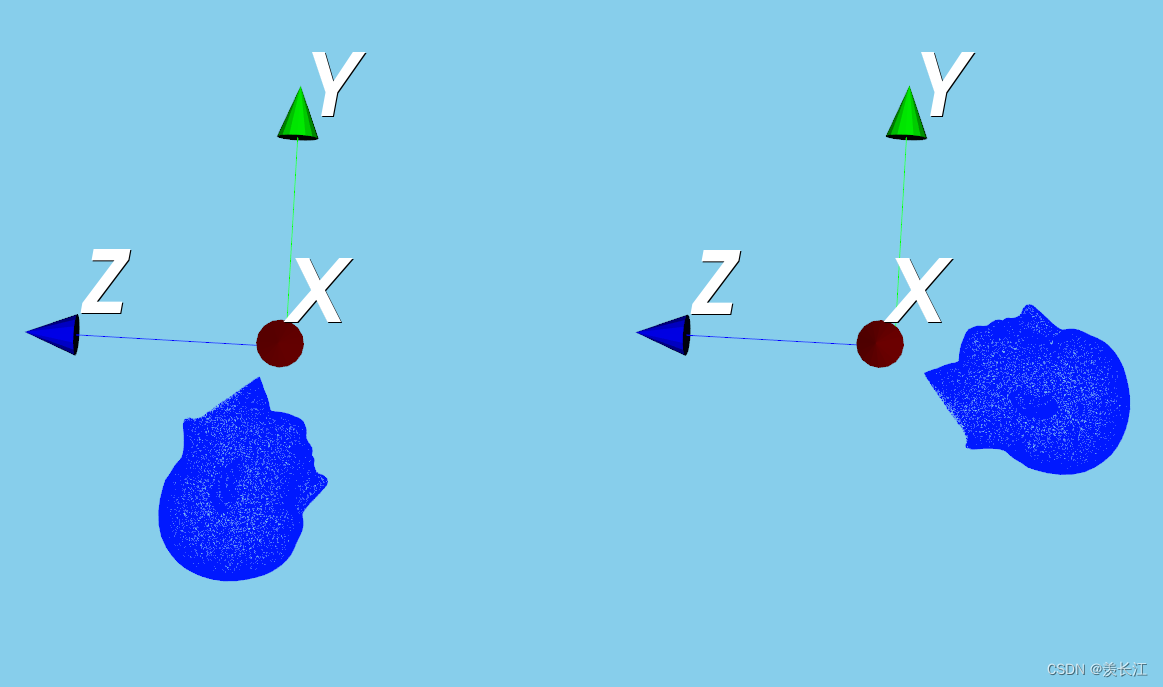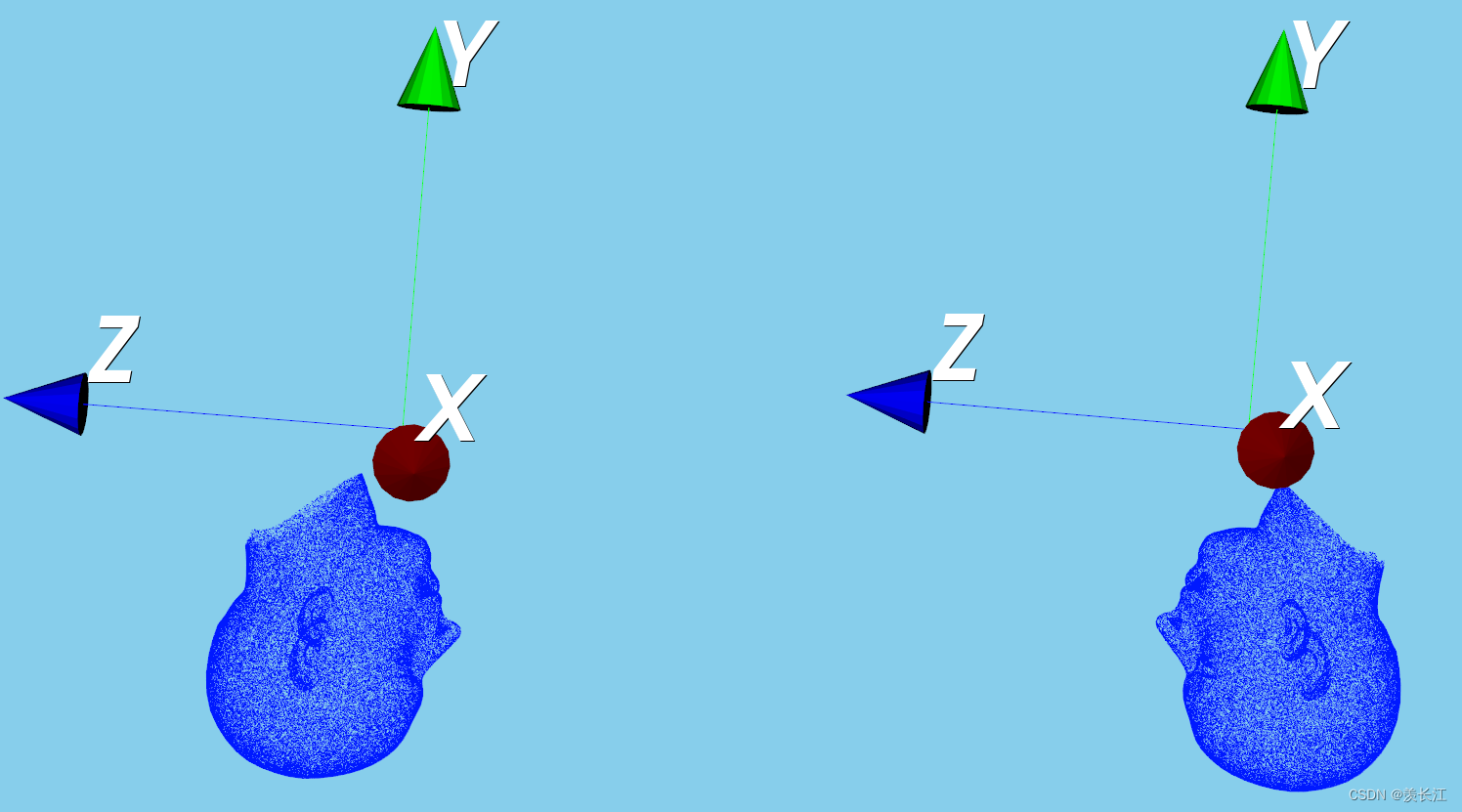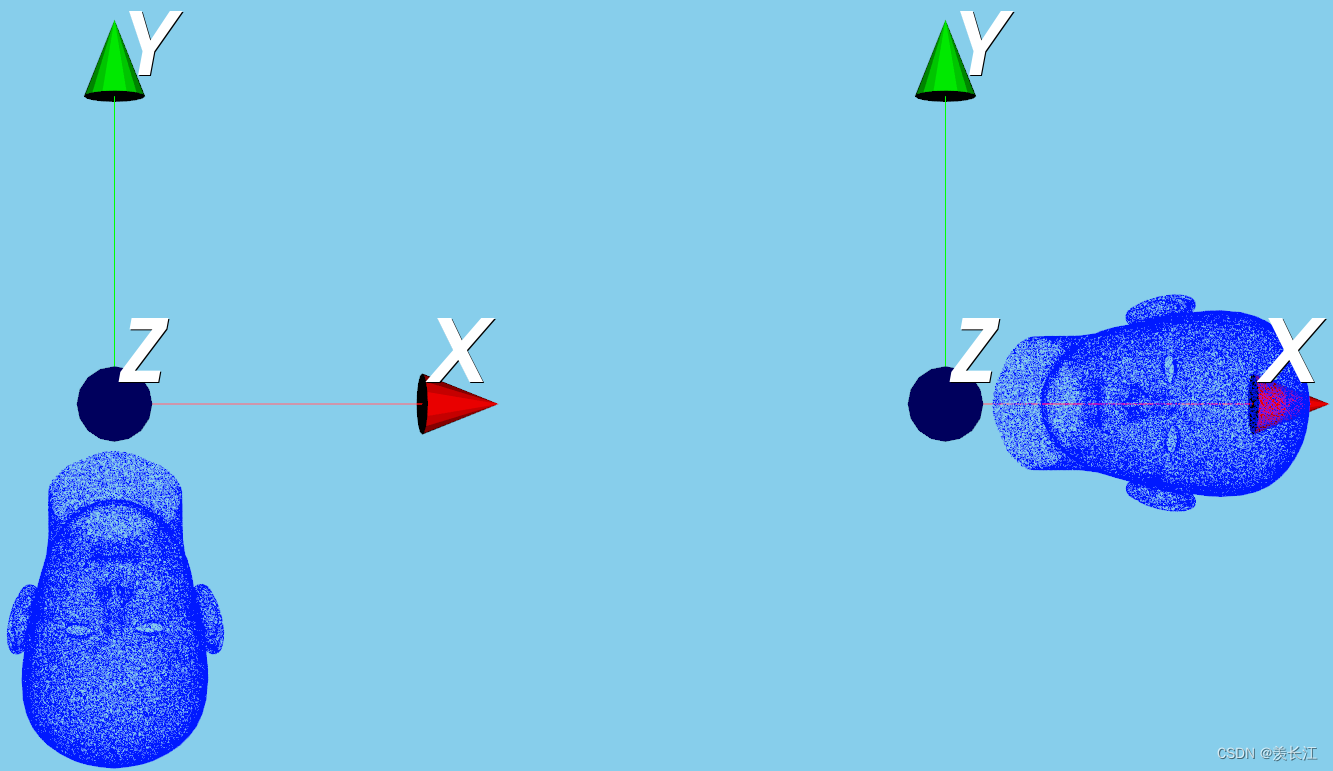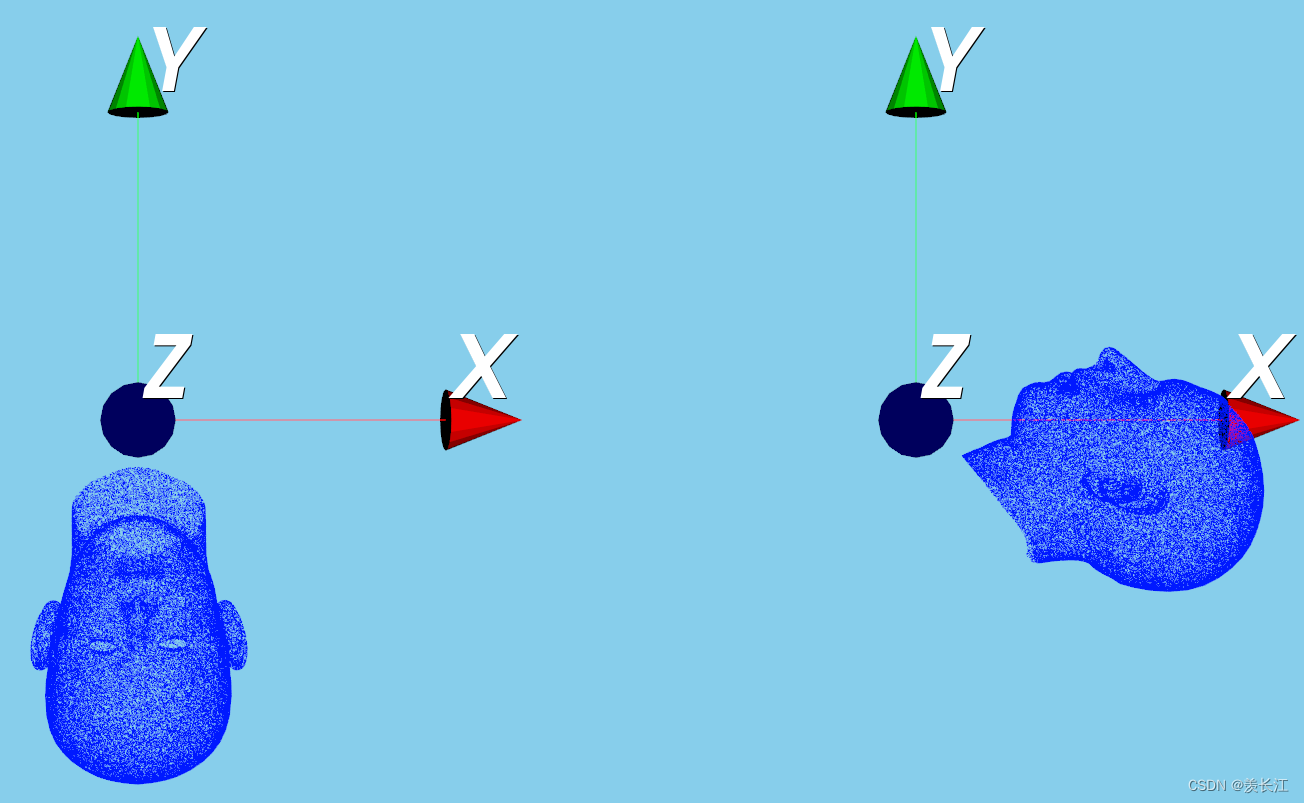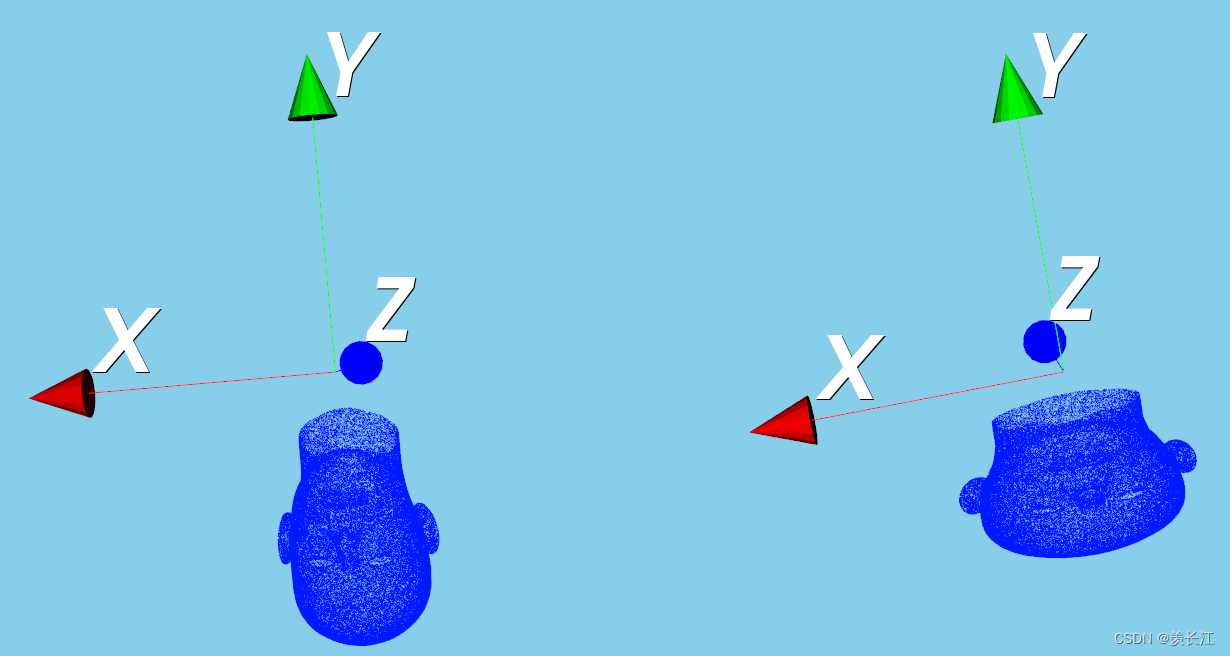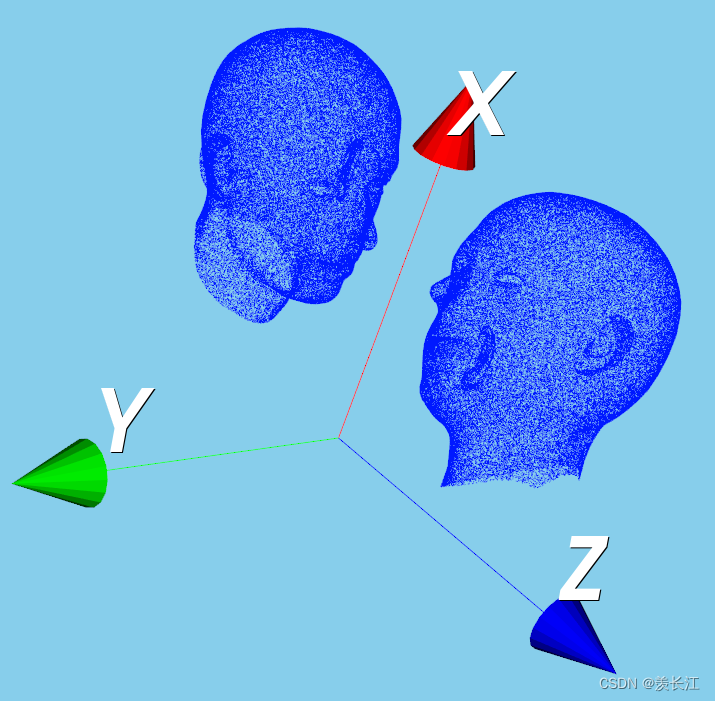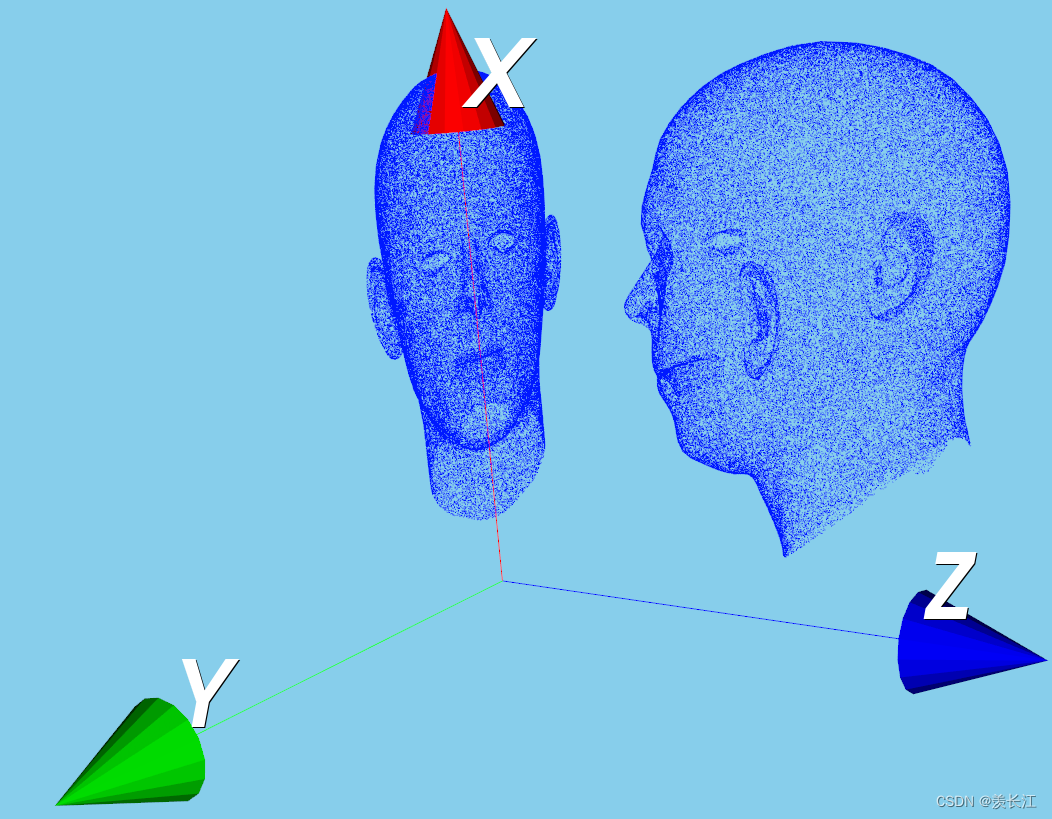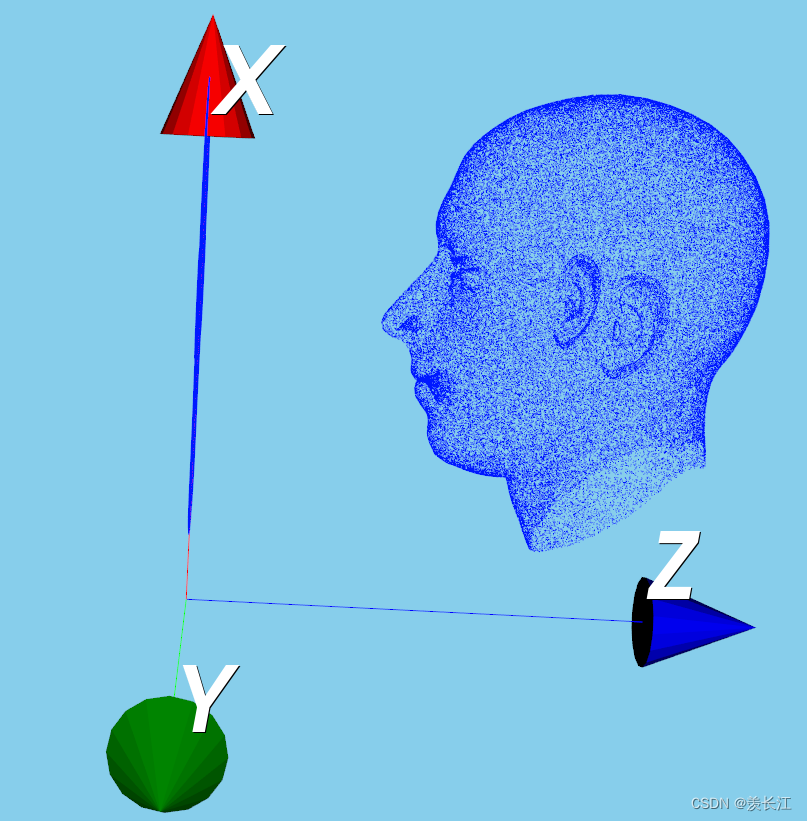| 三维变换矩阵实战 | 您所在的位置:网站首页 › matlab三维点 › 三维变换矩阵实战 |
三维变换矩阵实战
|
一、旋转矩阵(右手坐标系)
绕x轴旋转
旋转矩阵:右边矩阵是点云的原始坐标,左边的是旋转矩阵
可视化:绕x轴旋转90度
代码: import vtk import numpy as np import math def pointPolydataCreate(pointCloud): points = vtk.vtkPoints() cells = vtk.vtkCellArray() i = 0 for point in pointCloud: points.InsertPoint(i, point[0], point[1], point[2]) cells.InsertNextCell(1) cells.InsertCellPoint(i) i += 1 PolyData = vtk.vtkPolyData() PolyData.SetPoints(points) PolyData.SetVerts(cells) mapper = vtk.vtkPolyDataMapper() mapper.SetInputData(PolyData) actor = vtk.vtkActor() actor.SetMapper(mapper) actor.GetProperty().SetColor(0.0, 0.1, 1.0) return actor def visiualize(pointCloud, pointCloud2): colors = vtk.vtkNamedColors() actor1 = pointPolydataCreate(pointCloud) actor2 = pointPolydataCreate(pointCloud2) Axes = vtk.vtkAxesActor() # 可视化 renderer1 = vtk.vtkRenderer() renderer1.SetViewport(0.0, 0.0, 0.5, 1) renderer1.AddActor(actor1) renderer1.AddActor(Axes) renderer1.SetBackground(colors.GetColor3d('skyblue')) renderer2 = vtk.vtkRenderer() renderer2.SetViewport(0.5, 0.0, 1.0, 1) renderer2.AddActor(actor2) renderer2.AddActor(Axes) renderer2.SetBackground(colors.GetColor3d('skyblue')) renderWindow = vtk.vtkRenderWindow() renderWindow.AddRenderer(renderer1) renderWindow.AddRenderer(renderer2) renderWindow.SetSize(1040, 880) renderWindow.Render() renderWindow.SetWindowName('PointCloud') renderWindowInteractor = vtk.vtkRenderWindowInteractor() renderWindowInteractor.SetRenderWindow(renderWindow) renderWindowInteractor.Initialize() renderWindowInteractor.Start() pointCloud = np.loadtxt("C:/Users/A/Desktop/pointCloudData/model.txt") #读取点云数据 angel_x = 90 # 旋转角度 radian = angel_x * np.pi / 180 # 旋转弧度 Rotation_Matrix_1 = [ # 绕x轴三维旋转矩阵 [1, 0, 0], [0, math.cos(radian), -math.sin(radian)], [0, math.sin(radian), math.cos(radian)]] Rotation_Matrix_1 = np.array(Rotation_Matrix_1) p = np.dot(Rotation_Matrix_1, pointCloud.T) # 计算 p = p.T visiualize(pointCloud, p) 绕y轴旋转旋转矩阵:
可视化:绕y轴旋转180度
代码: angel_y = 180 # 旋转角度 radian = angel_y * np.pi / 180 # 旋转弧度 Rotation_Matrix_2 = [ # 绕y轴三维旋转矩阵 [math.cos(radian), 0, math.sin(radian)], [0, 1, 0], [-math.sin(radian), 0, math.cos(radian)]] Rotation_Matrix_1 = np.array(Rotation_Matrix_1) p = np.dot(Rotation_Matrix_1, pointCloud.T) # 计算 p = p.T visiualize(pointCloud, p) 绕z轴旋转旋转矩阵:
可视化:绕z轴旋转90度
代码: angel_z = 90 # 旋转角度 radian = angel_z * np.pi / 180 # 旋转弧度 Rotation_Matrix_1 = [ # 绕z轴三维旋转矩阵 [math.cos(radian), -math.sin(radian), 0], [math.sin(radian), math.cos(radian), 0], [0, 0, 1]] Rotation_Matrix_1 = np.array(Rotation_Matrix_1) p = np.dot(Rotation_Matrix_1, pointCloud.T) # 计算 p = p.T visiualize(pointCloud, p) 线绕z轴旋转,再绕x轴旋转:旋转矩阵: 线绕哪个轴转,xyz矩阵就和哪和轴的旋转矩阵先计算
可视化:先绕z轴旋转90度,再绕x轴旋转90度
代码: angel_z = 90 # 旋转角度 radian = angel_z * np.pi / 180 # 旋转弧度 Rotation_Matrix_z = [ # 绕z轴三维旋转矩阵 [math.cos(radian), -math.sin(radian), 0], [math.sin(radian), math.cos(radian), 0], [0, 0, 1]] angel_x = 90 # 旋转角度 radian = angel_x * np.pi / 180 # 旋转弧度 Rotation_Matrix_x = [ # 绕x轴三维旋转矩阵 [1, 0, 0], [0, math.cos(radian), -math.sin(radian)], [0, math.sin(radian), math.cos(radian)]] Rotation_Matrix_z = np.array(Rotation_Matrix_z) Rotation_Matrix_x = np.array(Rotation_Matrix_x) p = np.dot(Rotation_Matrix_z, pointCloud.T) # 计算 p = np.dot(Rotation_Matrix_x, p) # 计算 p = p.T visiualize(pointCloud, p) 二、缩放矩阵缩放矩阵: 计算过程:三个k是xyz对应的缩放系数
可视化:
3D镜像矩阵: 向量n是垂直于镜像平面的单位向量 三维点云对xz平面的镜像:①首先,确定一个垂直于xz平面的单位向量 n=[0, 1, 0] ②将该单位向量带入上述3D镜像矩阵 可视化:
代码: import vtk import numpy as np import math def pointPolydataCreate(pointCloud): points = vtk.vtkPoints() cells = vtk.vtkCellArray() i = 0 for point in pointCloud: points.InsertPoint(i, point[0], point[1], point[2]) cells.InsertNextCell(1) cells.InsertCellPoint(i) i += 1 PolyData = vtk.vtkPolyData() PolyData.SetPoints(points) PolyData.SetVerts(cells) mapper = vtk.vtkPolyDataMapper() mapper.SetInputData(PolyData) actor = vtk.vtkActor() actor.SetMapper(mapper) actor.GetProperty().SetColor(0.0, 0.1, 1.0) return actor def visiualize(pointCloud, pointCloud2): colors = vtk.vtkNamedColors() actor1 = pointPolydataCreate(pointCloud) actor2 = pointPolydataCreate(pointCloud2) Axes = vtk.vtkAxesActor() # 可视化 renderer1 = vtk.vtkRenderer() renderer1.SetViewport(0.0, 0.0, 0.5, 1) renderer1.AddActor(actor1) renderer1.AddActor(Axes) renderer1.SetBackground(colors.GetColor3d('skyblue')) renderer2 = vtk.vtkRenderer() renderer2.SetViewport(0.5, 0.0, 1.0, 1) renderer2.AddActor(actor1) renderer2.AddActor(actor2) renderer2.AddActor(Axes) renderer2.SetBackground(colors.GetColor3d('skyblue')) renderWindow = vtk.vtkRenderWindow() renderWindow.AddRenderer(renderer1) renderWindow.AddRenderer(renderer2) renderWindow.SetSize(1040, 880) renderWindow.Render() renderWindow.SetWindowName('PointCloud') renderWindowInteractor = vtk.vtkRenderWindowInteractor() renderWindowInteractor.SetRenderWindow(renderWindow) renderWindowInteractor.Initialize() renderWindowInteractor.Start() pointCloud = np.loadtxt("C:/Users/A/Desktop/pointCloudData/model.txt") #读取点云数据 nx = 0 ny = 0 nz = 1 n = [nx, ny, nz] # 垂直xy平面的单位向量 # 镜像矩阵 Mirror_Matrix = [ [1-2*nx**2, -2*nx*ny, -2*nx*nz], [-2*nx*ny, 1-2*ny**2, -2*ny*nz], [-2*nx*nz, -2*ny*nz, 1-2*nz**2]] Mirror_Matrix = np.array(Mirror_Matrix) p = np.dot(Mirror_Matrix, pointCloud.T) # 计算 p = p.T visiualize(pointCloud, p) 四、错切矩阵 沿xy平面错切(z不变)矩阵 计算过程
矩阵 计算过程
矩阵 计算过程
代码: pointCloud = np.loadtxt("C:/Users/A/Desktop/pointCloudData/model.txt") #读取点云数据 s = 0.3 t = 0.3 # 沿yz平面错切矩阵 Shear_Matrix = [ [1, 0, 0], [s, 1, 0], [t, 0, 1]] Shear_Matrix = np.array(Shear_Matrix) p = np.dot(Shear_Matrix, pointCloud.T) # 计算 p = p.T visiualize(pointCloud, p) 五、正交投影 正交投影矩阵(投影到三维空间任意平面):向量n是垂直于投影平面的单位向量 可视化:点云在xy平面上的正交投影
平移矩阵需要利用齐次矩阵(4*4矩阵),下面是一个平移矩阵 最右边一列是xyz的位移量
增加的平移对原来的线性变换没影响,可以将前面介绍的变换矩阵和平移结合 例如:沿xy平面错切+平移 |
【本文地址】
公司简介
联系我们
